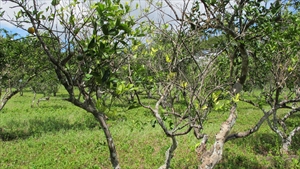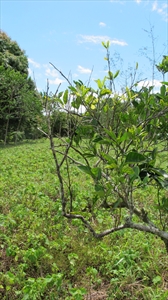- Worldwide distribution. On citrus. An important virus disease, with several strains.
- The virus spreads rapidly on the mouthparts of aphids feeding first on infected and then healthy trees.
- Strains cause: (i) no symptoms; (ii) slow or quick decline of scions (sweet orange, grapefruit, mandarin) on sour orange root stocks; (iii) stem pitting regardless of rootstock; (iv) seedling yellows.
- Biosecurity: not all strains are found in all countries.
- Cultural control: nursery plant certification; remove infected trees; use tolerant root stocks, e.g., trifoliata, Rampur lime, rough lemon, sweet orange. Choose root stocks based on tristeza strains, tolerance to soil pH, and drought.
- Chemical control: it is difficult to control Citrus tristeza virus by killing the aphids that spread it; this is because spread of the virus is fast, and occurs before the insecticide kills the aphid. However, control of aphids in nurseries may be beneficial. Use soap, white or horticultural oils; PDPs: neem, derris, pyrethrum, or chilli; or synthetic pyrethroids, but likely to kill natural enemies
Pacific Pests, Pathogens and Weeds - Online edition
Pacific Pests, Pathogens, Weeds & Pesticides
Citrus tristeza disease (250)
Citrus quick decline virus, grapefruit stem pitting; tristeza
Citrus tristeza virus, Citrus tristeza closterovirus. The abbreviation is CTV. The word "tristeza" is from Portuguese meaning "sadness".
AUTHOR Grahame Jackson
Information from CABI (2015) Citrus tristeza virus (grapefruit stem pitting). Crop Protection Compendium. (https://www.cabi.org/cpc/datasheet/16705); and Barkley P, et al. (undated) Citrus tristeza virus. Department of Employment, Economic Development and Innovation. Biosecurity Queensland. (https://www.daf.qld.gov.au/__data/assets/pdf_file/0019/71830/Citrus-Citrus-tristeza.pdf); and from Citrus diseases of tristeza. USDA, University of Florida. (https://idtools.org/id/citrus/diseases/factsheet.php?name=Tristeza). Photo 1 Richard Davis, Plant Pathologist, Northern Australia Quarantine Strategy, Department of Agriculture, Water and the Environment, Queensland, Australia.
Produced with support from the Australian Centre for International Agricultural Research under project PC/2010/090: Strengthening integrated crop management research in the Pacific Islands in support of sustainable intensification of high-value crop production, implemented by the University of Queensland and the Secretariat of the Pacific Community.






